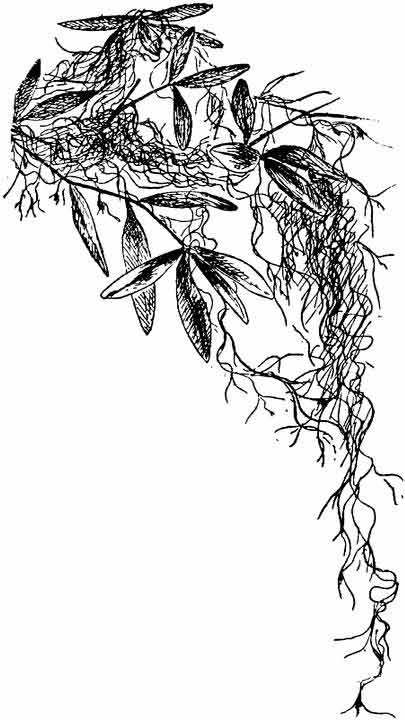
Spanish
Moss
by Sharon LaPlante
Spanish
moss is not a true moss, but rather a rootless epiphyte in the Bromeliaceae family and closely related
to the pineapple.
It does not parasitize its host, but rather uses the host only for
supporting its slender stems and foliage. Its stems,
about 1/25 of an inch in diameter and up to 50 inches in length, are elongated,
twining and covered with silvery-gray scales. The short, 1
to 2 1/2 inches in length, round leaves appear at numerous intervals. The
silvery-gray scales, called trichomes, serve two major purposes. The first is
the absorption of water and nutrients. The second
is to help reflect intense sunlight off of the leaf surface.
Its
flowers appear singly and inconspicuously on a 1/2 inch long stalk in the leaf
axil. The
petals are yellowish-green with recurved tips. Two long
bracts of unequal length extend beyond the flower. Flowers appear mostly in
April to June, and sporadically throughout the summer. The seed
capsule is 1/2 to 1 inch in length and spine tipped.
Many animals make use of Spanish moss. The Northern yellow bat, as well as other Lasiurus, uses it as a roost and a nursery for its young. Carolina wrens also use it to sleep in, as well as to search for food in. Swallow-tailed kites, as well as many other birds, use it in constructing their nests. Squirrels also use it as a nest building material.
Florida's
Indians used Spanish moss for making cordage, bedding, as a binder for clay pots
(to prevent them from cracking during firing), and added to the clay daubed on
the outside of certain houses. It
was used to some extent when green, but for the compact twisting of cordage it
had to be processed. The Indians
processed it by placing it in a shallow pond for six weeks after which time the
outer layer rotted away. The end
result was a black stringy fiber. The
women also used it for skirts with the processed fibers woven into a type of
fabric or in its original form.
Early
in this century collecting and preparing Spanish moss for industrial use was a
million dollar industry in the state of Florida.
The moss was used, after processing in much the same way the
Indians
processed it, for stuffing upholstery and mattresses.
It
is still used as stuffing material to some extent today. Crafters use it, unprocessed but
sterilized, in flower arrangements and other creations. It also makes a great mulch for
flowerbeds.
Brown, Robin C. Florida's First People. Pineapple Press: Sarasota, FL. 1994
Craighead, Frank C. Orchids and Other Air Plants of the Everglades National Park. University of Miami Press: Coral Gables, FL. 1963
Return to the Main Page
All material on this site © Hernando Chapter of the FNPS. The materials on this website may be copied and distributed without permission, provided that it is used for non-commercial, informational or educational purposes, and you acknowledge this site and the Hernando Chapter of the Florida Native Plant Society as the source of publication.